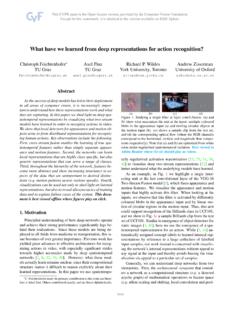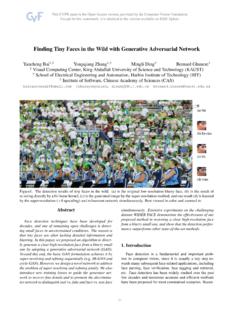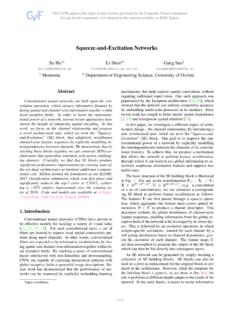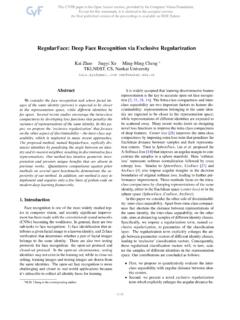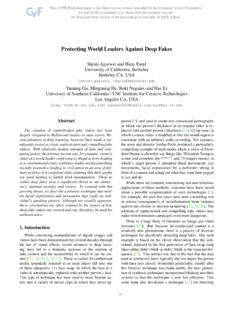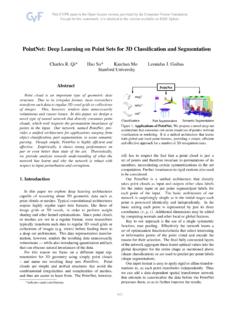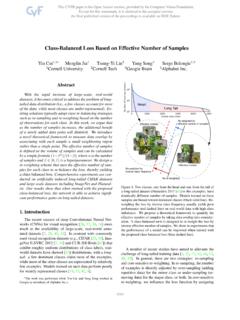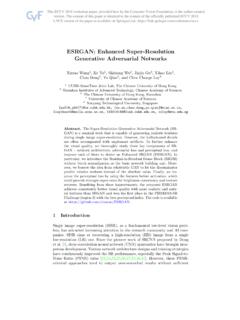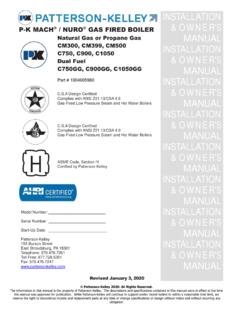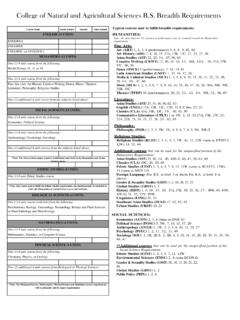Transcription of Frustum PointNets for 3D Object Detection From RGB-D Data
1 Frustum PointNets for 3D Object Detection from RGB-D DataCharles R. Qi1 Wei Liu2 Chenxia Wu2 Hao Su3 Leonidas J. Guibas11 Stanford University2 Nuro, San DiegoAbstractIn this work, we study 3D Object Detection from RGB-D data in both indoor and outdoor scenes. While previousmethods focus on images or 3D voxels, often obscuring nat-ural 3D patterns and invariances of 3D data, we directlyoperate on raw point clouds by popping up RGB-D , a key challenge of this approach is how to effi-ciently localize objects in point clouds of large-scale scenes(region proposal). Instead of solely relying on 3D propos-als, our method leverages both mature 2D Object detec-tors and advanced 3D deep learning for Object localization,achieving efficiency as well as high recall for even small ob-jects.
2 Benefited from learning directly in raw point clouds,our method is also able to precisely estimate 3D bound-ing boxes even under strong occlusion or with very sparsepoints. Evaluated on KITTI and SUN RGB-D 3D detectionbenchmarks, our method outperforms the state of the art byremarkable margins while having real-time IntroductionRecently, great progress has been made on 2D image un-derstanding tasks, such as Object Detection [10] and instancesegmentation [11]. However, beyond getting 2D boundingboxes or pixel masks,3D understandingis eagerly in de-mand in many applications such as autonomous driving andaugmented reality (AR).
3 With the popularity of 3D sensorsdeployed on mobile devices and autonomous vehicles, moreand more 3D data is captured and processed. In this work,we study one of the most important 3D perception tasks 3D Object Detection , which classifies the Object category andestimatesoriented 3D bounding boxesof physical objectsfrom 3D sensor 3D sensor data is often in the form of point clouds,how to represent point cloud and what deep net architec-tures to use for 3D Object Detection remains an open prob-lem. Most existing works convert 3D point clouds to im-ages by projection [30,21] or to volumetric grids by quan-tization [33,18,21] and then apply convolutional networks.
4 Majority of the work done as an intern at Nuro, pointcloud2 Dregion(fromCNN) to 3 Dfrustum3 Dbox(fromPointNet)Figure Object Detection RGB-D data, wefirst generate 2D Object region proposals in the RGB image using aCNN. Each 2D region is then extruded to a3D viewing frustuminwhich we get a point cloud from depth data. Finally, our frustumPointNet predicts a (oriented and amodal) 3D bounding box forthe Object from the points in data representation transformation, however, may ob-scure natural 3D patterns and invariances of the data. Re-cently, a number of papers have proposed to process pointclouds directly without converting them to other example, [20,22] proposed new types of deep net archi-tectures, calledPointNets, which have shown superior per-formance and efficiency in several 3D understanding taskssuch as Object classification and semantic PointNets are capable of classifying a whole pointcloud or predicting a semantic class for each point in a pointcloud, it is unclear how this architecture can be used forinstance-level 3D Object Detection .
5 Towards this goal, wehave to address one key challenge: how to efficiently pro-pose possible locations of 3D objects in a 3D space. Imi-tating the practice in image Detection , it is straightforwardto enumerate candidate 3D boxes by sliding windows [7]or by 3D region proposal networks such as [27]. However,the computational complexity of 3D search typically growscubically with respect to resolution and becomes too ex-pensive for large scenes or real-time applications such asautonomous , in this work, we reduce the search space fol-lowing the dimension reduction principle: we take the ad-vantage of mature 2D Object detectors ( ).
6 First, weextract the 3D bounding Frustum of an Object by extruding2D bounding boxes from image detectors. Then, within the3D space trimmed by each of the 3D frustums, we consecu-tively perform 3D Object instance segmentation andamodal19183D bounding box regression using two variants of Point-Net. The segmentation network predicts the 3D mask ofthe Object of interest ( instance segmentation); and theregression network estimates the amodal 3D bounding box(covering the entire Object even if only part of it is visible).In contrast to previous work that treats RGB-D data as2D maps for CNNs, our method is more3D-centricas welift depth maps to 3D point clouds and process them us-ing 3D tools.
7 This 3D-centric view enables new capabilitiesfor exploring 3D data in a more effective manner. First,in our pipeline, a few transformations are applied succes-sively on 3D coordinates, which align point clouds into asequence of more constrained and canonical frames. Thesealignments factor out pose variations in data, and thus make3D geometry pattern more evident, leading to an easier jobof 3D learners. Second, learning in 3D space can better ex-ploits the geometric and topological structure of 3D principle, all objects live in 3D space; therefore, we be-lieve that many geometric structures, such as repetition, pla-narity, and symmetry, are more naturally parameterized andcaptured by learners that directly operate in 3D space.
8 Theusefulness of this 3D-centric network design philosophy hasbeen supported by much recent experimental method achieve leading positions on KITTI 3D ob-ject Detection [1] and bird s eye view Detection [2] bench-marks. Compared with the previous state of the art [5], ourmethod on 3D car AP with high efficiency(running at 5 fps). Our method also fits well to indoor RGB-D data where we have 3 DmAP than [13] and [24] on SUN-RGBD while running oneto three orders of magnitude key contributions of our work are as follows: We propose a novel framework for RGB-D data based3D Object Detection called Frustum PointNets . We show how we can train 3D Object detectors un-der our framework and achieve state-of-the-art perfor-mance on standard 3D Object Detection benchmarks.
9 We provide extensive quantitative evaluations to vali-date our design choices as well as rich qualitative re-sults for understanding the strengths and limitations ofour Related Work3D Object Detection from RGB-D DataResearchershave approached the 3D Detection problem by taking var-ious ways to represent RGB-D view image based methods:[3,19,34] takemonocular RGB images and shape priors or occlusion pat-terns to infer 3D bounding boxes. [15,6] represent depthdata as 2D maps and apply CNNs to localize objects in 2 Dimage. In comparison we represent depth as a point cloudand use advanced 3D deep networks ( PointNets ) that canexploit 3D geometry more s eye view based methods:MV3D [5] projects Li-DAR point cloud to bird s eye view and trains a region pro-posal network (RPN [23]) for 3D bounding box , the method lags behind in detecting small objects,such as pedestrians and cyclists and cannot easily adapt toscenes with multiple objects in vertical based methods:[31,28] train 3D Object classifiersby SVMs on hand-designed geometry features extractedfrom point cloud and then localize objects using sliding-window search.
10 [7] extends [31] by replacing SVM with3D CNN on voxelized 3D grids. [24] designs new geomet-ric features for 3D Object Detection in a point cloud. [29,14]convert a point cloud of the entire scene into a volumetricgrid and use 3D volumetric CNN for Object proposal andclassification. Computation cost for those method is usu-ally quite high due to the expensive cost of 3D convolutionsand large 3D search space. Recently, [13] proposes a 2D-driven 3D Object Detection method that is similar to oursin spirit. However, they use hand-crafted features (basedon histogram of point coordinates) with simple fully con-nected networks to regress 3D box location and pose, whichis sub-optimal in both speed and performance.
